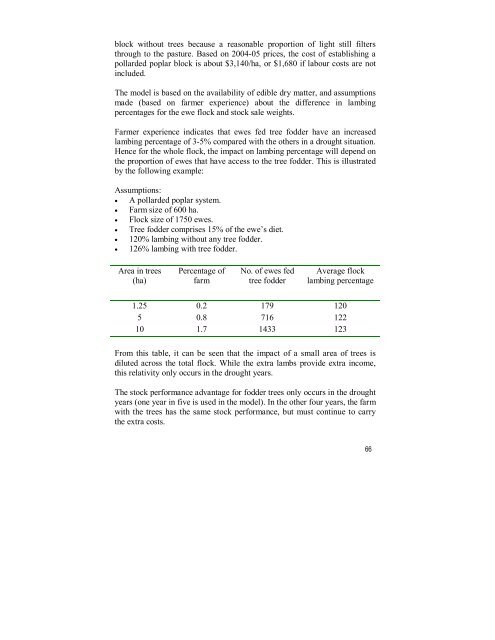Growing Poplar and Willow Trees on Farms, National - FAO
Growing Poplar and Willow Trees on Farms, National - FAO
Growing Poplar and Willow Trees on Farms, National - FAO
Create successful ePaper yourself
Turn your PDF publications into a flip-book with our unique Google optimized e-Paper software.
lock without trees because a reas<strong>on</strong>able proporti<strong>on</strong> of light still filters<br />
through to the pasture. Based <strong>on</strong> 2004-05 prices, the cost of establishing a<br />
pollarded poplar block is about $3,140/ha, or $1,680 if labour costs are not<br />
included.<br />
The model is based <strong>on</strong> the availability of edible dry matter, <str<strong>on</strong>g>and</str<strong>on</strong>g> assumpti<strong>on</strong>s<br />
made (based <strong>on</strong> farmer experience) about the difference in lambing<br />
percentages for the ewe flock <str<strong>on</strong>g>and</str<strong>on</strong>g> stock sale weights.<br />
Farmer experience indicates that ewes fed tree fodder have an increased<br />
lambing percentage of 3-5% compared with the others in a drought situati<strong>on</strong>.<br />
Hence for the whole flock, the impact <strong>on</strong> lambing percentage will depend <strong>on</strong><br />
the proporti<strong>on</strong> of ewes that have access to the tree fodder. This is illustrated<br />
by the following example:<br />
Assumpti<strong>on</strong>s:<br />
• A pollarded poplar system.<br />
• Farm size of 600 ha.<br />
• Flock size of 1750 ewes.<br />
• Tree fodder comprises 15% of the ewe’s diet.<br />
• 120% lambing without any tree fodder.<br />
• 126% lambing with tree fodder.<br />
Area in trees<br />
(ha)<br />
Percentage of<br />
farm<br />
No. of ewes fed<br />
tree fodder<br />
Average flock<br />
lambing percentage<br />
1.25 0.2 179 120<br />
5 0.8 716 122<br />
10 1.7 1433 123<br />
From this table, it can be seen that the impact of a small area of trees is<br />
diluted across the total flock. While the extra lambs provide extra income,<br />
this relativity <strong>on</strong>ly occurs in the drought years.<br />
The stock performance advantage for fodder trees <strong>on</strong>ly occurs in the drought<br />
years (<strong>on</strong>e year in five is used in the model). In the other four years, the farm<br />
with the trees has the same stock performance, but must c<strong>on</strong>tinue to carry<br />
the extra costs.<br />
66

















